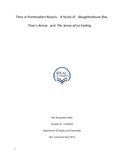| dc.contributor.advisor | Islam, Syed Manzoorul | |
| dc.contributor.author | Arefin, Md. Maqsudul | |
| dc.date.accessioned | 2014-06-23T08:33:55Z | |
| dc.date.available | 2014-06-23T08:33:55Z | |
| dc.date.issued | 2014-04 | |
| dc.identifier.other | ID 11363010 | |
| dc.identifier.uri | http://hdl.handle.net/10361/3325 | |
| dc.description | This thesis report submitted in partial fulfillment of the requirements for the degree of Bachelors of Arts in English at the Department of English and Humanities of BRAC University, 2014. | en_US |
| dc.description | Cataloged from PDF version of thesis report. | |
| dc.description | Includes bibliographical references (page 32-33). | |
| dc.description.abstract | The study attempts to illustrate how Kurt Vonnegut, Martin Amis and Julian Burnes depict time in keeping with postmodernist practice and the three novelists present a new aspect of time . In the introductory part, the paper has talked about the long-established ideas on time and some debatable points of time. In the next part , the study has tried to depict how time is structured in the eighteenth, nineteenth and twentieth century English literature. In the eighteenth and nineteenth century, the novels are based on traditional concept of time. It indicates clock-governed fiction. The 20th century novel talks about new psychology and the paper argues that psychology has a great connection with time. Later the research has explained that postmodern novelists talk about a new reality that it is a reality beyond over a reality. In Slaughterhouse-5, time is connected with the glorification of science fiction .Time in Slaughterhouse-five is science fiction time .In Time’s Arrow , we realize that nothing is correct in the world. Neither Tod Friendly nor Tony Webster can comprehend reality as well as time. They even do not know themselves. So, it is not possible for them to realize time. In The Sense of an Ending , Julian Burnes demonstrates that memory and time are interconnected. Tony Webster tries to construct his memory but his memory is fragmented . Like Billy Pilgrim and Tod Friendly, we see divided self in Tony Webster’s personality. The research tries to discuss, compare and contrast Slaughterhouse-five, Time’s Arrow, and The Sense of an Ending with some theories and books . Finally, the research tries to elucidate that time in the postmodern novel is totally different from the novels of eighteenth and nineteenth century because new ideologies and World War I and World War II and there is no particular definition and ideology of time in postmodern novels . | en_US |
| dc.format.extent | 33 pages | |
| dc.language.iso | en | en_US |
| dc.publisher | BRAC University | en_US |
| dc.rights | BRAC University thesis reports are protected by copyright. They may be viewed from this source for any purpose, but reproduction or distribution in any format is prohibited without written permission. | |
| dc.subject | English and humanities | en_US |
| dc.title | Time in postmodern novels: A study of slaughterhouse-five, time’s arrow and the sense of an ending | en_US |
| dc.type | Thesis | en_US |
| dc.contributor.department | Department of English and Humanities, BRAC University | |
| dc.description.degree | M. in English | |

